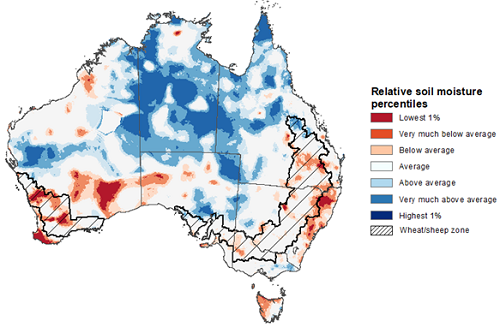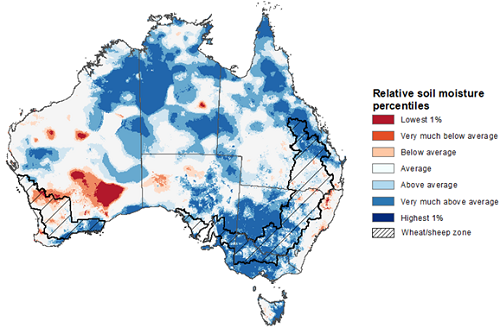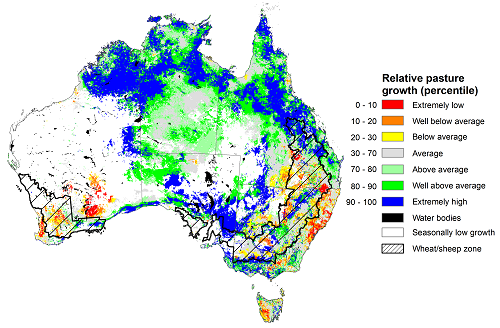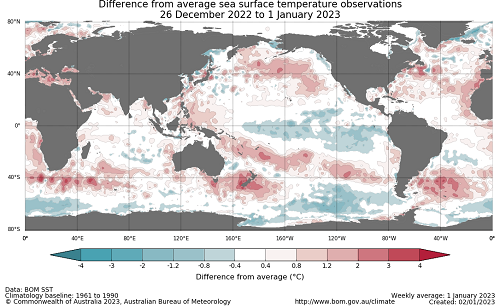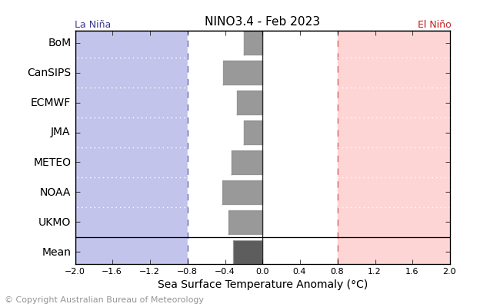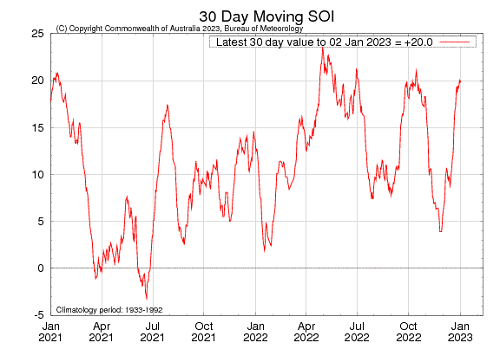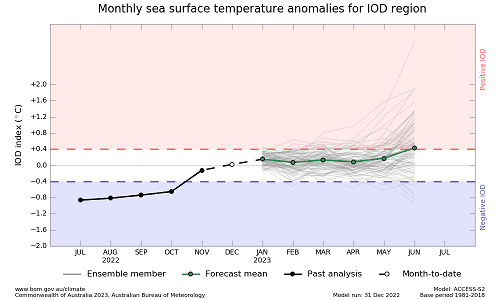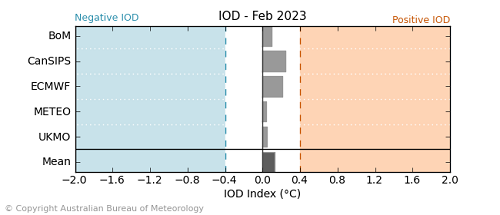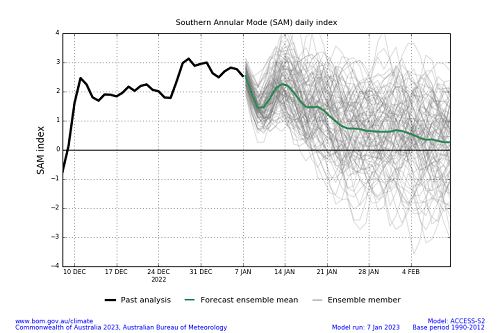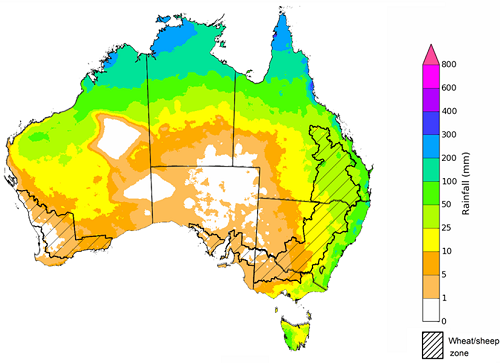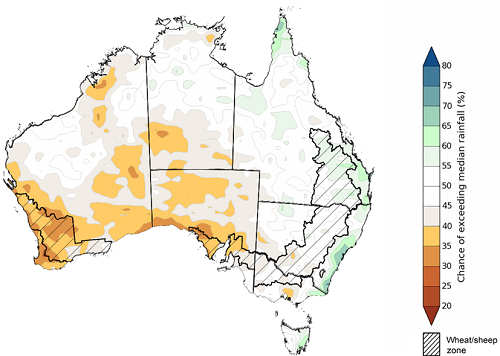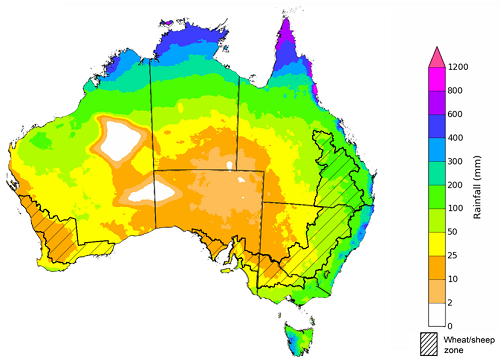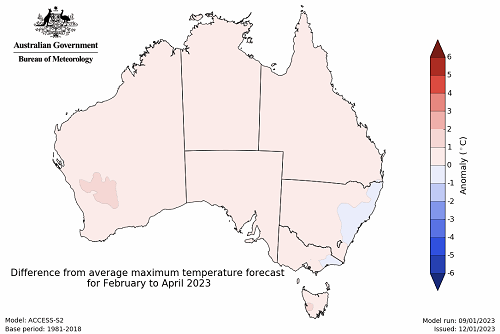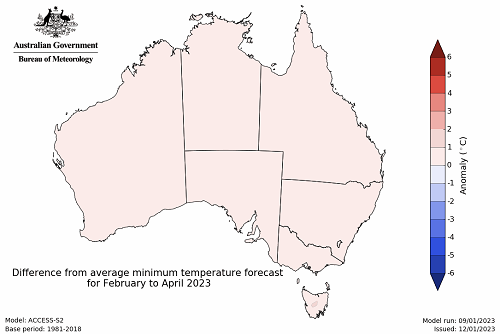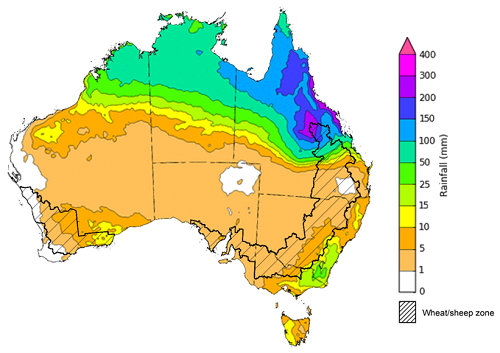Key issues
- For the week ending 11 January 2023, tropical cyclone activity and seasonal thunderstorms brought widespread rainfall across most of northern Australia. In Australian cropping regions, rainfall totals of between 15 and 50 millimetres were recorded across much of northern and central Queensland. Little to no rainfall was recorded in remaining cropping regions for the week ending 11 January 2023. The persistence of dry condition across cropping regions of Victoria, South Australia and Western Australia would have continued to support the harvesting of winter crops (see Section 1.1).
- December 2022 rainfall was 33% above average for Australia as a whole but below average to average across cropping regions of Australia. Below average to average rainfall in December benefited the harvest of winter crops across Victoria, South Australia and Western Australia, while average rainfall still allowed harvesting activities to recommence across New South Wales, following severe disruptions in November due to heavy rainfall (see Section 1.2).
- Across much of New South Wales, Victoria, Queensland, South Australia and parts of Western Australia above average to extremely high pasture growth will likely enable farmers to continue rebuilding stock numbers and provide opportunities to replenish fodder supplies during late spring or early summer (see Section 1.4).
- La Niña under way in the tropical Pacific is slowly weakening and expected to dissipate by February. The active Madden-Julian Oscillation in the western Pacific Ocean is expected to move into the Atlantic in the coming days and remain there for the next two weeks, increasing the monsoon activities across the Australian region. Those climate drivers will bring above average rainfall across northern and eastern Australia and below average rainfall for western Tasmania during summer (see Section 1.5).
- The rainfall outlook for February to April 2023 suggests most of the country has close to equal chance of above or below median rainfall. Root zone soil moisture levels across both northern and southern cropping regions are above average. Therefore, close to average rainfall during this period is unlikely to negatively impact summer crops growth and yield prospects (see Section 1.6).
- Over the 8-days to 19 January 2023, widespread rainfall is expected across most of northern Australia. However, little to no rainfall is forecast across most of Australian cropping regions. The continuation of dry conditions will likely further allow saturated soil to drain, however, a flooding risk remains for some areas. Little to no rainfall forecast across most cropping regions is likely to provide favourable conditions for crop harvesting and summer crop planting (see Section 1.7).
- Water storage levels in the Murray-Darling Basin (MDB) decreased between 4 January 2023 and 11 January 2023 by 131 gigalitres (GL). Current volume of water held in storage is 23 803 GL which represents 94 percent of total capacity. This is 4 percent or 1012 (GL) more than at the same time last year.
- Allocation prices in the Victorian Murray below the Barmah Choke remained steady at $40 per ML from 30 December 2022 to 6 January 2023. Prices are lower in the Murrumbidgee and regions above the Barmah choke due to the binding of the Murrumbidgee export limit and Barmah choke trade constraint.
Climate
For the week ending 11 January 2023, tropical cyclone activity and seasonal thunderstorms brought widespread rainfall across most of northern Australia. Ex-Tropical Cyclone Ellie brought heavy rainfall and major flooding in Northern Territory and northern Western Australia.
Weekly rainfall of more than 50 millimetres was recorded in large parts of northern Australia and in pockets along the east coast. More than 150 millimetres rainfall was received in the Broome area of Western Australia, Tanami district in Northern Territory and most of the Cape York Peninsula of northern Queensland. In contrast, little to no rainfall was recorded across most of southern Australia outside the eastern coastal area.
In Australian cropping regions, rainfall totals of between 15 and 50 millimetres were recorded across much of northern and central Queensland. Little to no rainfall was recorded in remaining cropping regions.
The persistence of dry condition across cropping regions of Victoria, South Australia and Western Australia would have continued to support the harvesting of winter crops. Across parts of southern Queensland and northern New South Wales, little rainfall would have allowed access for field work related to the planting and maintenance of summer crops.
Rainfall for the week ending 11 January 2023
Note: The rainfall analyses and associated maps utilise data contained in the Bureau of Meteorology climate database, the Australian Data Archive for Meteorology (ADAM). The analyses are initially produced automatically from real-time data with limited quality control. They are intended to provide a general overview of rainfall across Australia as quickly as possible after the observations are received. For further information go to http://www.bom.gov.au/climate/rainfall/
Rainfall during December 2022 was 33% above average for Australia as a whole. Rainfall was above or very much above average for most of the Northern Territory, western Queensland and the Cape York Peninsula, the eastern half of the Kimberley and the Gascoyne in Western Australia. For the Northern Territory as a whole, December area-averaged rainfall was the 8th-highest on record (compared with all Decembers since 1900). In contrast, below average to average rainfall was recorded for parts of the southern half of Australia, particularly in south-west and inland southern Western Australia, eastern New South Wales and south-eastern Queensland, and western and northern Tasmania.
December 2022 rainfall was below average to average across cropping regions of Australia, with very much below average rainfall occurring within scattered areas of south-eastern Queensland, north-eastern New South Wales, and south-western Western Australia.
Below average to average rainfall in December allowed the harvest of winter crops across Victoria, South Australia and Western Australia, while average December rainfall allowed harvest activities to recommence across New South Wales, following severe disruptions in November due to heavy rainfall.
Rainfall percentiles for December 2022
Generally, upper layer soil moisture for December 2022 was at average or better levels for this time of year across most of Australia, following reduced rainfall through the month. However, it had significantly geographic differences between the north and south of Australia, reflecting the spatial pattern of rainfall during December 2022. Extremely low upper soil moisture was modelled for some parts of the eastern New South Wales coastline, southern Western Australia, as well as small areas of south-eastern Queensland and eastern South Australia. Extremely high upper layer moisture was evident across large areas of the Northern Territory, western Queensland and the Cape York Peninsula, parts of north-eastern and central South Australia, and Gascoyne in Western Australia, as well as along the border between Western Australia and the North Territory.
At this time of year, upper layer soil moisture is important for late planted summer crops in northern New South Wales and Queensland and for pasture growth across northern Australia since plant germination and establishment utilise this moisture. It is also an important indicator of the ability to access paddocks for winter crop harvesting and summer crop planting activities.
Upper layer soil moisture was below average to average for this time of year across most cropping regions in Queensland, New South Wales, Victoria and South Australia, as well as the south half of Western Australia. Extremely low levels of upper layer soil moisture were present for some parts of central Western Australia. Lower levels of upper layer soil moisture would have allowed paddock access to progress winter crop harvest in southern Australia, while average soil moisture would have encouraged crop planting and germination for northern cropping regions.
Modelled upper layer soil moisture for December 2022
Source: Bureau of Meteorology (Australian Water Resources Assessment Landscape model).
Lower layer soil moisture for December 2022 was well above average to extremely high for this time of year across large parts of the country outside of north-western and inland southern Western Australia and western Tasmania. Lower layer soil moisture was below average to extremely low in parts of inland southern Western Australia and small areas of Pilbara and Barkly Tablelands, as well as scattered areas of north-eastern New South Wales. Modelled lower layer soil moisture was average to above average across the remainder of the country.
Lower layer soil moisture will be important to support summer crops and pasture growth during the peak growth period. In Australian cropping regions, lower layer soil moisture was extremely high across much of New South Wales, northern Queensland, Victoria, South Australia, and southern Western Australia. Lower layer soil moisture was below average to average across large cropping area of southern Queensland, and northern and central Western Australia. High levels of lower layer soil moisture will continue to support above average yield prospects for summer crops and above average pasture growth for this time of year across New South Wales and southern Queensland.
Modelled lower layer soil moisture for December 2022
Source: Bureau of Meteorology (Australian Water Resources Assessment Landscape model).
Pasture growth during the October to December period was typically low across large areas of Western Australia, reflecting low rainfall totals at this time of year. Across southern Australia, October to December is the peak pasture growth period which typically provides a bulk of feed and allows for fodder conservation to maintain production through the low pasture growth months of summer. It also influences the growth, branding and marking rates of lambs and calves, and the production of meat, milk, and wool over this peak production period.
For the 3 months to December 2022 above average rainfall totals and mild temperatures resulted in well above average pasture production for this time of year across most grazing regions in eastern, southern and northern Australia.
Modelled pasture growth was above average to extremely high across much of New South Wales, Victoria, Queensland, South Australia and parts of Western Australia. This growth will likely enable farmers to continue rebuilding stock numbers and provide opportunities to replenish fodder supplies during late spring or early summer, if conditions, such as dry warm weather suitable for fodder conservation continue over the coming weeks. In contrast, modelled pasture growth was extremely low to below average across scattered areas of central, eastern and southern New South Wales, southern Queensland, and southern parts of Western Australia. In some regions this low pasture growth likely reflects a decline in plant growth due to excess moisture.
Relative pasture growth for 3-months ending December 2022 (1 October to 31 December 2022)
Source: Queensland Department of Science, Information Technology and Innovation.
Throughout Australia’s summer period the climate drivers with the largest potential impact on Australia’s climate patterns are the El Niño–Southern Oscillation (ENSO), the Southern Annular Mode (SAM), and the Madden-Julian Oscillation (MJO). These climate drivers are likely to influence the growth and development of summer crops in northern growing regions and pasture growth across northern Australia with the onset of the northern wet season.
La Niña remains active in the tropical Pacific but is slowly weakening. Cool sea surface temperature (SST) anomalies have persisted in the central and eastern tropical Pacific Ocean in recent weeks. However, the strength and extent of cool SST anomalies have weakened in the eastern equatorial Pacific. Warmer than average temperatures continue in the far-west of the Pacific, with generally small anomalies over the Maritime Continent, and larger anomalies to the northeast of Australia. Warm temperature anomalies have also reduced in strength over the Coral Sea (to the north-east of Australia), especially off the Queensland coast. Trade winds have been stronger than average in the western and central Pacific. Elsewhere, trade wind strength was close to average. Cloudiness has been mostly below average near the Date Line, which reflects the La Niña event.
Sea surface temperature across the northern Indian Ocean has been reduced to be generally close to average over the last three weeks, reflecting a neutral IOD event. The SAM is currently strongly positive. An MJO of weak strength is currently active over the western Pacific Ocean and expected to move into the Atlantic in the coming days and remain weak for much of the coming days. Given current and expected conditions, including the La Niña event and a positive SAM, above average rainfall is expected to persist across northern and eastern Australia and below average rainfall for western Tasmania during summer.
Difference from average sea surface temperature observations 26 December 2022 to 1 January 2023
International climate model outlooks for the NINO 3.4 region in February 2023
Issued: 04/01/2023
The La Niña event currently underway in the Pacific Ocean is slowly easing. All seven of the international models surveyed predict an easing La Niña event in January and all models expect the La Niña event to dissipate by February 2023. For the period ending 2 January 2023, the 30-day Southern Oscillation Index (SOI) value was +20.0 and the 90-day value was +14.3. The 30-day value has increased over the past fortnight. La Niña events are associated with above average rainfall across eastern and northern Australia during summer.
30-day Southern Oscillation Index (SOI) values ending 2 January 2023
The current IOD in the Indian Ocean is neutral and has little influence on the Australian climate while the monsoon trough is in the southern hemisphere (typically December to April). As of ending of 1 January 2023, the Indian Ocean Dipole (IOD) weekly index value was +0.07°C, within neutral bounds (between -0.4°C and +0.4°C).
Current sea surface temperatures are generally close to average across most of the Indian Ocean, although weak warm anomalies are present over some areas to the north of the basin, as well as off the coast of Western Australia and in parts of the Maritime Continent. Warm sea surface temperatures in the east of the Indian Ocean tend to result in wetter conditions in summer. All five international climate models surveyed by the Bureau of Meteorology predict the neutral IOD event to persist throughout summer and into the southern hemisphere autumn.
Monthly sea surface temperature anomalies for IOD region
International climate model outlooks for the IOD in February 2023
Issued: 04/01/2023
The Southern Annular Mode (SAM) has been strongly positive since late December and is likely to remain positive until at least mid-January. The positive phase of the SAM is being boosted by La Niña and a strong polar vortex over Antarctica. The SAM refers to the north-south shift of the band of rain-bearing westerly winds and weather systems in the Southern Ocean compared to the usual position. A positive SAM in summer months is associated with increased rainfall for parts of north-eastern Tasmania, eastern Victoria, eastern New South Wales and south-eastern Queensland. It is also associated with decreased rainfall for western Tasmania.
Southern Annular Mode (SAM) daily index
Since the last week of December, the Madden–Julian Oscillation (MJO) has been in the western Pacific Ocean, increasing the monsoon activities across the Australian region. As of 2 January 2023, it is expected to move into the Atlantic in the coming days, remaining there for the next two weeks. The MJO is a pulse of cloud and rainfall that moves eastwards along the equator. A MJO pulse in the Atlantic at this time of year may significantly reduce cloudiness across northern Australia.
Madden–Julian Oscillation (MJO) daily index
These climate outlooks are generated by ACCESS–S (Australian Community Climate Earth-System Simulator–Seasonal). ACCESS–S is the Bureau of Meteorology's dynamic (physics-based) weather and climate model used for monthly, seasonal, and longer-lead climate outlooks. For further information, go to http://www.bom.gov.au/climate/ahead/about/.
The Bureau of Meteorology’s latest rainfall outlook for February 2023 indicates most of the country has close to equal chance of above or below median rainfall. The ACCESS-S climate model suggests there is a greater than 60% chance of exceeding median rainfall for eastern Tasmania, eastern Victoria and Queensland’s Capricornia district. Below median rainfall is also likely (greater than 60% chance) for the isolated parts of Cape York, the Northern Territory and South Australia.
The outlook for February 2023 indicates that there is a 75% chance of rainfall totals between 10 and 200 millimetres across central and eastern New South Wales, much of Queensland, southern Victoria, much of the Northern Territory, and northern Western Australia, as well as Tasmania. Rainfall totals in excess of 200 millimetres are expected across far north areas of Queensland and the Northern Territory. For the remainder of Australia, rainfall totals are not expected to exceed 10 millimetres.
Across cropping regions there is a 75% chance of rainfall totals of between 10 and 50 millimetres across much of New South Wales and Queensland. There is a 75% chance of less than 10 millimetres of rainfall for cropping regions in Western Australia, South Australia, and most of Victoria, and the far south-west of New South Wales.
Rainfall totals that have a 75% chance of occurring February 2023
Issued:12/01/2023
The rainfall outlook for February to April 2023 suggests most of eastern Australia has close to equal chance of above median rainfall. There is an around 60% chance of exceeding median rainfall for southern coastal parts of New South Wales, far-eastern Victoria and parts of eastern Tasmania. However, below median rainfall is more likely much of Western Australia, central Australia and most of South Australia between February to April.
Bureau of Meteorology rainfall outlooks for February to April have greater than 55% past accuracy across most of Australia. Outlook accuracy is greater than 65% across parts of Queensland, New South Wales, South Australia, and the north-west and northern parts of Western Australia, as well as northern parts of the Northern Territory. Past accuracy is low (less than 50%) for small parts of Western Australia, Queensland, and southern Tasmania.
Chance of exceeding the median rainfall February to April 2023
Issued: 12/01/2023
The outlook for February to April 2023 suggests there is a 75% chance of rainfall totals between 25 and 200 millimetres across most of Queensland, New South Wales, Victoria, the Northern Territory, Tasmania, as well as large areas of Western Australia. Rainfall totals in excess of 200 millimetres are forecast for tropic north, alpine and eastern coastal areas of Australia, and south-west Tasmania.
Across cropping regions, there is a 75% chance of receiving less than 50 millimetres in the cropping regions of south-western New South Wales, most of Victoria, South Australia and Western Australia. There is a 75% chance of receiving between 50 and 200 millimetres across the remainder of New South Wales and Queensland.
These rainfall totals are below average for this three-month period across most cropping regions. Root zone soil moisture levels across both northern and southern cropping regions are above average. Therefore, below average rainfall during the February to April period is unlikely to negatively impact summer crops growth and yield prospects.
Rainfall totals that have a 75% chance of occurring February to April 2023
Issued: 12/01/2023
The temperature outlook for February to April 2023 indicates that maximum temperatures across most of Australia are likely to be close to the 1990-2012 average (the difference in the range of - 1°C to +1°C), with slightly higher than average maximum temperatures across south-western Western Australia. Minimum temperatures across most of Australia are expected to be close to the 1990-2012 average (the difference in the range of 0°C to +1°C) (Bureau of Meteorology ‘National Climate Outlook’, 5 January 2023).
Predicted maximum temperature anomaly for February to April 2023
Predicted minimum temperature anomaly for February to April 2023
Over the 8-days to 19 January 2023, rainfall is expected across most of northern Australia. A monsoonal trough and low-pressure systems are expected to bring heavy rainfall and storms to large areas of tropic north and northeast of Australia. Meanwhile, high pressure systems are expected to bring dry conditions to much of the reminder of Australia, with the exception of the south-east corner.
Rainfall totals exceeding 10 millimetres are expected across much of Queensland and the Northern Territory and Kimberley in Western Australia, and parts of southeast corner of Australia, as well as small areas of north-west corner and the south of Western Australia. Rainfall of more than 100 millimetres is forecast for much of northern and north-eastern Queensland.
Little to no rainfall is forecast across most of Australian cropping regions for the next eight days. The main exception is expected to be northern Queensland where rainfall totals of between 10 to 150 millimetres are expected.
The continuation of dry conditions will likely further allow saturated soil to drain in the flood-affected cropping regions of south-eastern Australia, however, major flooding has been continuing across the Murray Darling Basin. Peak water flows have passed the South Australian border causing major flooding but a flood risk remains at some areas as flood waters make their way further downstream. Little to no rainfall forecast across most cropping regions will provide favourable conditions for crop harvesting and summer crop planting.
Total forecast rainfall for the period 12 January to 19 January 2023
Note: This rainfall forecast is produced from computer models. As the model outputs are not altered by weather forecasters, it is important to check local forecasts and warnings issued by the Bureau of Meteorology.
Water
Water storages, water markets and water allocations - current week
The Tableau dashboard may not meet accessibility requirements. For information about the contents of these dashboards contact ABARES.
Commodities
Information on weekly price changes in agricultural commodities is now available at the Weekly commodity price update.

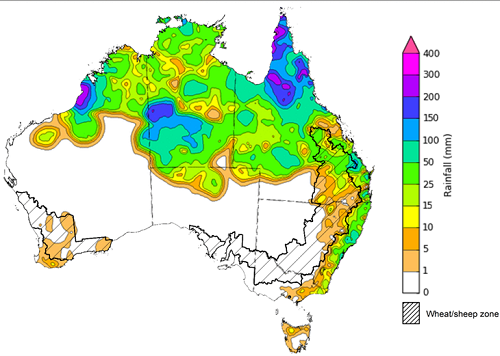
![Map showing the rainfall percentiles for the previous month in Australia. Image provided by the Bureau of Meteorology. Please refer to accompanying text for a more detailed description.]](/sites/default/files/images/Monthly_rainfall_20221231.png)
